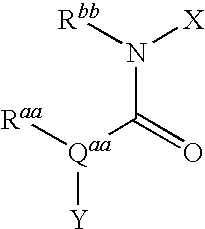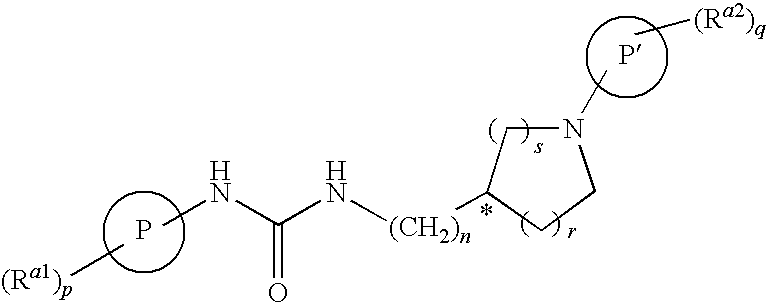Tetrahydro-quinolinylurea derivatives
a technology of tetrahydroquinolinylurea and derivatives, which is applied in the direction of biocide, cardiovascular disorder, drug compositions, etc., can solve the problems of affecting the normal use serious drawbacks of oral active anticholinergic drugs, and inability to meet the needs of patients,
- Summary
- Abstract
- Description
- Claims
- Application Information
AI Technical Summary
Benefits of technology
Problems solved by technology
Method used
Image
Examples
example 1-1
N-[4-chloro-3-(trifluoromethyl)phenyl]-N′-(3-hydroxy-1-methyl-1,2,3,4tetrahydroquinolin-5-yl)urea
[0316]
[0317]A mixture of 5-amino-1-methyl-1,2,3,4-tetrahydroquinolin-3-ol and 4-chloro-3-trifluoromethyl-phenyl isocyanate in tetrahydrofuran is stirred at 50° C. for 5 hours. After removing the solvent, the resulting residue is purified by silica gel column chromatography to provide N-[4-chloro-3-(trifluoromethyl)phenyl]-N′-(3-hydroxy-1-methyl-1,2,3,4-tetrahydroquinolin-5-yl)urea.
[0318]In a similar manner as described in Example 1-1, compounds shown below are synthesized.
[0319]
Examplemp—X——R1-201bond1-311bond1-401bond1-502—O—1-602—O—1-700—NH—1-800—NH—
[0320]
Examplemp—X——R2-101bond2-201bond2-301—O—2-400—O—2-500—NH—2-610bond2-711bond2-811bond
[0321]
Examplemp—X——R3-110bond3-220bond3-300—O—3-400—O—3-500—NH—3-611bond3-711bond
[Staring Compound B]
Ethyl 3-(2,6-dinitrophenyl)-2-oxopropanoate
[0322]
[0323]2,6-Dinitrotoluene (10.0 g, 54.9 mmol) and oxalic acid diethylester (16.1 g, 110 mmol) are disso...
example 4-1
N-(3-Hydroxy-2-oxo-1,2,3,4-tetrahydroquinolin-5-yl)-N′-[4-(trifluoromethyl)benzyl]urea
[0334]
[0335]5-Amino-3-hydroxy-3,4-dihydroquinolin-2(1H)-one (300 mg, 1.68 mmol) is dissolved in ethyl acetate and cooled to 0° C. 4-Trifluoromethylbenzylisocyanate (339 mg, 1.68 mmol) is added slowly with stirring. The reaction mixture is stirred for 1 h at room temperature. The insoluble product is filtered and dried in vacuo. Yield: 103 mg (16%).
[0336]1H-NMR (DMSO, 300 MHz): δ 10.08 (s, 1H), 8.01 (s, 1H), 7.70 (d, 2H), 7.52 (d, 2H), 7.41 (d, 1H), 7.12-6.95 (m, 2H), 6.54 (d, 1H), 5.42 (d, 1H), 4.40 (d, 1H), 4.18-4.02 (m, 1H), 3.09 (dd, 1H), 2.61 (dd, 1H). Molecular weight: 379 MS (ESI+): 380 (M+H)+
example 4-2
N-(3-Hydroxy-1,2,3,4-tetrahydroquinolin-5-yl)-N′-[4-(trifluoromethyl)benzyl]urea
[0337]
[0338]5-Amino-1,2,3,4-tetrahydroquinolin-3-ol (36.4 mg, 0.22 mmol) is dissolved in dichloromethane and cooled to −20° C. 4-Trifluoromethylbenzylisocyanate (44.6 mg, 0.22 mmol) is added and the reaction mixture is warmed to room temperature over 4 h. The organic layer is diluted with dichloromethane, washed with aq. NH4Cl and water. The organic phase is dried over magnesium sulfate, filtered and evaporated to dryness. The crude product consists of a mixture of regioisomers and is separated using preparative HPLC with an acetonitrile / water gradient.
[0339]1H-NMR (DMSO, 500 MHz): δ 7.71 (d, 2H), 7.60 (s, 1H), 7.51 (d, 2H), 7.04 (t, 1H), 6.97 (d, 1h), 6.75 (t, 1H), 6.15 (d, 1H), 5.58 (s, 1H), 4.95 (d, 1H), 4.37 (d, 2H), 3.92-3.83 (m, 1H), 3.17 (d, 1H), 2.81 (t, 1H), 2.73 (dd, 1H), 2.30 (dd, 1H). Molecular weight: 365 MS (ESI+): 366.1 (M+H)+.
PUM
| Property | Measurement | Unit |
|---|---|---|
| temperature | aaaaa | aaaaa |
| temperature | aaaaa | aaaaa |
| temperature | aaaaa | aaaaa |
Abstract
Description
Claims
Application Information
 Login to View More
Login to View More - R&D
- Intellectual Property
- Life Sciences
- Materials
- Tech Scout
- Unparalleled Data Quality
- Higher Quality Content
- 60% Fewer Hallucinations
Browse by: Latest US Patents, China's latest patents, Technical Efficacy Thesaurus, Application Domain, Technology Topic, Popular Technical Reports.
© 2025 PatSnap. All rights reserved.Legal|Privacy policy|Modern Slavery Act Transparency Statement|Sitemap|About US| Contact US: help@patsnap.com



